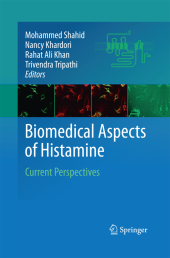 Neuerscheinungen 2014Stand: 2020-02-01 |
Schnellsuche
ISBN/Stichwort/Autor
|
Herderstraße 10
10625 Berlin
Tel.: 030 315 714 16
Fax 030 315 714 14
info@buchspektrum.de |

Rahat Ali Khan, Nancy Khardori, Mohammed Shahid, Trivendra Tripathi
(Beteiligte)
Biomedical Aspects of Histamine
Current Perspectives
Herausgegeben von Shahid, Mohammed; Khardori, Nancy; Khan, Rahat Ali; Tripathi, Trivendra
2011. 2014. xxxv, 441 S. 235 mm
Verlag/Jahr: SPRINGER NETHERLANDS; SPRINGER 2014
ISBN: 940178499X (940178499X)
Neue ISBN: 978-9401784993 (9789401784993)
Preis und Lieferzeit: Bitte klicken
Biomedical Aspects of Histamine presents a compendium of the current literature on histamine, its receptors and their agnonists and antagonists. It provides a comprehensive overview of histamine biology in the fields of biochemistry, cell and molecular biology, immunology, neurobiology, and more.
Since its identification by Sir Henry H. Dale a century ago, histamine has become one of the most important multifunctional biogenic amines in the field of biomedicine. The pharmacological effects of histamine are mediated through four types of membrane histamine receptors; H1R, H2R, H3R and H4R, which are all heptahelical G-protein-coupled receptors. It has been known to play the broadest spectrum of activities in various physiological and pathological conditions including cell proliferation, differentiation, hematopoiesis, embryonic development, regeneration, wound healing, aminergic neurotransmission and numerous brain functions, secretion of pituitary hormones, regulation of gastrointestinal and circulatory functions, cardiovascular system, as well as inflammatory reactions, modulation of the immune response, endocrine function and homeostasis, and other important areas.
This book is a compendium of the current state of established and investigational literature on Histamine, its receptors and their Agonists and antagonists. It provides a comprehensive overview of histamine biology in the field of biochemistry, cell biology, molecular biology, immunology, allergy, neurobiology, pharmacology, microbiology and reproductive biology. The first section on Histamine biology and physiology leads into subsequent sections on enzymology, pharmacology, regulation of the immune system and cell proliferation and role in allergic and other diseases including acid peptic diseases, inflammatory diseases, autoimmune and cancer diseases, nervous system, reproductive functions and hematopoiesis. The compilation of chapters in the book presents the most recent advances in histamine research and bridges the basic and clinical aspects of histamine biology.


